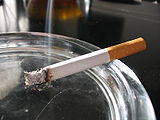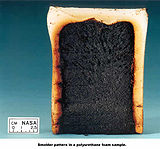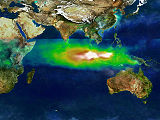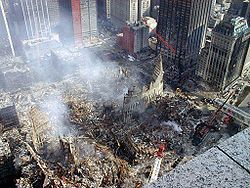
Smoulder
Encyclopedia

Flame
A flame is the visible , gaseous part of a fire. It is caused by a highly exothermic reaction taking place in a thin zone...
less form of combustion
Combustion
Combustion or burning is the sequence of exothermic chemical reactions between a fuel and an oxidant accompanied by the production of heat and conversion of chemical species. The release of heat can result in the production of light in the form of either glowing or a flame...
, sustained by the heat evolved when oxygen directly attacks the surface of a condensed-phase fuel. Many solid materials can sustain a smouldering reaction, including coal
Coal
Coal is a combustible black or brownish-black sedimentary rock usually occurring in rock strata in layers or veins called coal beds or coal seams. The harder forms, such as anthracite coal, can be regarded as metamorphic rock because of later exposure to elevated temperature and pressure...
, cellulose
Cellulose
Cellulose is an organic compound with the formula , a polysaccharide consisting of a linear chain of several hundred to over ten thousand β linked D-glucose units....
, wood
Wood
Wood is a hard, fibrous tissue found in many trees. It has been used for hundreds of thousands of years for both fuel and as a construction material. It is an organic material, a natural composite of cellulose fibers embedded in a matrix of lignin which resists compression...
, cotton
Cotton
Cotton is a soft, fluffy staple fiber that grows in a boll, or protective capsule, around the seeds of cotton plants of the genus Gossypium. The fiber is almost pure cellulose. The botanical purpose of cotton fiber is to aid in seed dispersal....
, tobacco
Tobacco
Tobacco is an agricultural product processed from the leaves of plants in the genus Nicotiana. It can be consumed, used as a pesticide and, in the form of nicotine tartrate, used in some medicines...
, peat
Peat
Peat is an accumulation of partially decayed vegetation matter or histosol. Peat forms in wetland bogs, moors, muskegs, pocosins, mires, and peat swamp forests. Peat is harvested as an important source of fuel in certain parts of the world...
, duff
Duff
In addition to its dictionary meanings, Duff may refer to:-Given name:*Duff, King of Scots ancestor of the Earls of Fife*Duff Cooper, British diplomat*Duff Goldman, star of Food Network's reality show Ace of Cakes...
, humus, synthetic foams, charring polymers including polyurethane
Polyurethane
A polyurethane is any polymer composed of a chain of organic units joined by carbamate links. Polyurethane polymers are formed through step-growth polymerization, by reacting a monomer with another monomer in the presence of a catalyst.Polyurethanes are...
foam, and some types of dust
Dust
Dust consists of particles in the atmosphere that arise from various sources such as soil dust lifted up by wind , volcanic eruptions, and pollution...
. Common examples of smouldering phenomena are the initiation of residential fires on upholstered furniture by weak heat sources (e.g., a cigarette
Cigarette
A cigarette is a small roll of finely cut tobacco leaves wrapped in a cylinder of thin paper for smoking. The cigarette is ignited at one end and allowed to smoulder; its smoke is inhaled from the other end, which is held in or to the mouth and in some cases a cigarette holder may be used as well...
, a short-circuited wire), and the persistent combustion of biomass
Biomass
Biomass, as a renewable energy source, is biological material from living, or recently living organisms. As an energy source, biomass can either be used directly, or converted into other energy products such as biofuel....
behind the flaming front of wildfire
Wildfire
A wildfire is any uncontrolled fire in combustible vegetation that occurs in the countryside or a wilderness area. Other names such as brush fire, bushfire, forest fire, desert fire, grass fire, hill fire, squirrel fire, vegetation fire, veldfire, and wilkjjofire may be used to describe the same...
s.
Fundamentals

Flame
A flame is the visible , gaseous part of a fire. It is caused by a highly exothermic reaction taking place in a thin zone...
combustion is that smouldering occurs on the surface of the solid rather than in the gas phase. Smouldering is a surface phenomenon but can propagate to the interior of a porous fuel if it is permeable to flow. The characteristic temperature
Temperature
Temperature is a physical property of matter that quantitatively expresses the common notions of hot and cold. Objects of low temperature are cold, while various degrees of higher temperatures are referred to as warm or hot...
and heat
Heat
In physics and thermodynamics, heat is energy transferred from one body, region, or thermodynamic system to another due to thermal contact or thermal radiation when the systems are at different temperatures. It is often described as one of the fundamental processes of energy transfer between...
released during smouldering are low compared to those in the flaming combustion (i.e., ~600 °C vs. ~1500 °C). Smouldering propagates in a creeping fashion, around 0.1 mm/s, which is about ten times slower than flames spread over a solid. In spite of its weak combustion characteristics, smouldering is a significant fire hazard. Smouldering emits toxic gases (e.g., carbon monoxide
Carbon monoxide
Carbon monoxide , also called carbonous oxide, is a colorless, odorless, and tasteless gas that is slightly lighter than air. It is highly toxic to humans and animals in higher quantities, although it is also produced in normal animal metabolism in low quantities, and is thought to have some normal...
) at a higher yield than flaming fires and leaves behind a significant amount of solid residue. The emitted gases are flammable and could later be ignited in the gas phase, triggering the transition to flaming combustion.
Smouldering materials

Tobacco
Tobacco is an agricultural product processed from the leaves of plants in the genus Nicotiana. It can be consumed, used as a pesticide and, in the form of nicotine tartrate, used in some medicines...
, decaying wood
Wood
Wood is a hard, fibrous tissue found in many trees. It has been used for hundreds of thousands of years for both fuel and as a construction material. It is an organic material, a natural composite of cellulose fibers embedded in a matrix of lignin which resists compression...
and sawdust, biomass
Biomass
Biomass, as a renewable energy source, is biological material from living, or recently living organisms. As an energy source, biomass can either be used directly, or converted into other energy products such as biofuel....
fuels on the forest surface (duff) and subsurface (peat
Peat
Peat is an accumulation of partially decayed vegetation matter or histosol. Peat forms in wetland bogs, moors, muskegs, pocosins, mires, and peat swamp forests. Peat is harvested as an important source of fuel in certain parts of the world...
), cotton
Cotton
Cotton is a soft, fluffy staple fiber that grows in a boll, or protective capsule, around the seeds of cotton plants of the genus Gossypium. The fiber is almost pure cellulose. The botanical purpose of cotton fiber is to aid in seed dispersal....
clothing and string, and polymeric foams (e.g., upholstery
Upholstery
Upholstery is the work of providing furniture, especially seats, with padding, springs, webbing, and fabric or leather covers. The word upholstery comes from the Middle English word upholder, which referred to a tradesman who held up his goods. The term is equally applicable to domestic,...
and bedding
Bedding
Bedding refers to the materials laid above the mattress of a bed for hygiene, warmth, to protect the mattress, and for decorative effect. Bedding is the removable and washable portion of a human sleeping environment. It is more easily and economically replaced than the bed itself...
materials). Smouldering fuels are generally porous, permeable to flow and formed by aggregates (particulates, grains, fibres or of cellular structure). These aggregates facilitate the surface reaction with oxygen by allowing gas flow through the fuel and providing a large surface area per unit volume. They also act as thermal insulation, reducing heat losses.
The most studied materials to date are cellulose
Cellulose
Cellulose is an organic compound with the formula , a polysaccharide consisting of a linear chain of several hundred to over ten thousand β linked D-glucose units....
and polyurethane
Polyurethane
A polyurethane is any polymer composed of a chain of organic units joined by carbamate links. Polyurethane polymers are formed through step-growth polymerization, by reacting a monomer with another monomer in the presence of a catalyst.Polyurethanes are...
foams.
Threats from smouldering
The characteristics of smouldering fires make them a threat of new dimensions, taking the form of colossal underground fires or silent fire safety risks, as summarized below.- Fire safetyFire safetyFire safety refers to precautions that are taken to prevent or reduce the likelihood of a fire that may result in death, injury, or property damage, alert those in a structure to the presence of a fire in the event one occurs, better enable those threatened by a fire to survive, or to reduce the...
: The main hazards posed by smouldering arise from the fact that it can be easily initiated (by heat sources too weak to ignite flames) and is difficult to detect. Fire statistics draw attention to the magnitude of smouldering combustion as the leading cause of fire deaths in residential areas (i.e., more than 25% of the fire deaths in the United StatesUnited StatesThe United States of America is a federal constitutional republic comprising fifty states and a federal district...
are attributed to smoulder-initiated fires, with similar figures in other developed countries). A particularly common fire scenario is a cigaretteCigaretteA cigarette is a small roll of finely cut tobacco leaves wrapped in a cylinder of thin paper for smoking. The cigarette is ignited at one end and allowed to smoulder; its smoke is inhaled from the other end, which is held in or to the mouth and in some cases a cigarette holder may be used as well...
igniting a piece of upholstered furnitureUpholsteryUpholstery is the work of providing furniture, especially seats, with padding, springs, webbing, and fabric or leather covers. The word upholstery comes from the Middle English word upholder, which referred to a tradesman who held up his goods. The term is equally applicable to domestic,...
. This ignition leads to a smouldering fire that lasts for a long period of time (in the order of hours), spreading slowly and silently until critical conditions are attained and flames suddenly erupt; fire-resistant cigarettesFire safe cigarettesFire safe cigarettes are cigarettes that are designed to extinguish more quickly than standard cigarettes, if ignored, with the intention of preventing accidental fires. These products are also known as Lower Ignition Propensity , Reduced Fire Risk , self-extinguishing, fire-safe or Reduced...
have been developed to reduce the risk of fire due to smouldering. Smouldering combustion is also a fire-safety concern aboard space facilities (e.g., International Space StationInternational Space StationThe International Space Station is a habitable, artificial satellite in low Earth orbit. The ISS follows the Salyut, Almaz, Cosmos, Skylab, and Mir space stations, as the 11th space station launched, not including the Genesis I and II prototypes...
), because the absence of gravity is thought to promote smouldering ignition and propagation. - WildfireWildfireA wildfire is any uncontrolled fire in combustible vegetation that occurs in the countryside or a wilderness area. Other names such as brush fire, bushfire, forest fire, desert fire, grass fire, hill fire, squirrel fire, vegetation fire, veldfire, and wilkjjofire may be used to describe the same...
s: Smouldering combustion of the forest ground does not have the visual impact of flaming combustion; however, it has importance consequences for the forestForestA forest, also referred to as a wood or the woods, is an area with a high density of trees. As with cities, depending where you are in the world, what is considered a forest may vary significantly in size and have various classification according to how and what of the forest is composed...
ecosystem. Smouldering of biomassBiomassBiomass, as a renewable energy source, is biological material from living, or recently living organisms. As an energy source, biomass can either be used directly, or converted into other energy products such as biofuel....
can linger for days or weeks after flaming has ceased, resulting in large quantities of fuels consumed and becoming a global source of emissionExhaust gasExhaust gas or flue gas is emitted as a result of the combustion of fuels such as natural gas, gasoline/petrol, diesel fuel, fuel oil or coal. According to the type of engine, it is discharged into the atmosphere through an exhaust pipe, flue gas stack or propelling nozzle.It often disperses...
s to the atmosphere. The slow propagation leads to prolonged heating and might cause sterilizations of the soil or the killing of rootRootIn vascular plants, the root is the organ of a plant that typically lies below the surface of the soil. This is not always the case, however, since a root can also be aerial or aerating . Furthermore, a stem normally occurring below ground is not exceptional either...
s, seedSeedA seed is a small embryonic plant enclosed in a covering called the seed coat, usually with some stored food. It is the product of the ripened ovule of gymnosperm and angiosperm plants which occurs after fertilization and some growth within the mother plant...
s, and plant stemPlant stemA stem is one of two main structural axes of a vascular plant. The stem is normally divided into nodes and internodes, the nodes hold buds which grow into one or more leaves, inflorescence , conifer cones, roots, other stems etc. The internodes distance one node from another...
s at the ground level.

- Subsurface fires: Fires occurring many meters below the surface are a type of smouldering event of colossal magnitude. Subsurface fires in coal mines, peat lands and landfills are rare events, but when active they can smoulder for very long periods of time (months or years), emitting enormous quantities of combustion gases into the atmosphere, causing deterioration of air quality and subsequent health problems. The oldest and largest fires in the world, burning for centuries, are smouldering fires. These fires are fed by the oxygen in the small but continuous flow of air through natural pipe networks, fractured strataStratumIn geology and related fields, a stratum is a layer of sedimentary rock or soil with internally consistent characteristics that distinguish it from other layers...
, cracks, openings or abandoned mineMiningMining is the extraction of valuable minerals or other geological materials from the earth, from an ore body, vein or seam. The term also includes the removal of soil. Materials recovered by mining include base metals, precious metals, iron, uranium, coal, diamonds, limestone, oil shale, rock...
shafts which permit the air to circulate into the subsurface. The reduced heat losses and high thermal inertia of the underground together with high fuel availability promote long-term smouldering combustion and allow for creeping but extensive propagation. These fires prove difficult to detect, and frustrate most efforts to extinguish them. The dramatic 1997 peatland fires in Borneo caused the recognition of subsurface smouldering fires as a global threat with significant economic, social and ecological impacts. The summer of 2006 saw the resurgence of the Borneo peat fires.

- World Trade Center DebrisWorld Trade Center siteThe World Trade Center site , also known as "Ground Zero" after the September 11 attacks, sits on in Lower Manhattan in New York City...
: After the attack, fire and subsequent collapse of the Twin TowersCollapse of the World Trade CenterThe twin towers of the World Trade Center collapsed on September 11, 2001, as a result of al-Qaeda's September 11 attacks, in which terrorists affiliated with al-Qaeda hijacked four commercial passenger jet airliners, flying one into the North Tower and another into the South Tower...
on September 11 2001September 11, 2001 attacksThe September 11 attacks The September 11 attacks The September 11 attacks (also referred to as September 11, September 11th or 9/119/11 is pronounced "nine eleven". The slash is not part of the pronunciation...
, the colossal pile of debris left on the site smouldered for more than five months. It resisted attempts by fire fighters to extinguish it until most of the rubble was removed. The effects of the gaseous and aerosolized products of smouldering on the health of the emergency workers were significant but the details are still a matter of debate.
Beneficial applications
Smouldering combustion also has a few beneficial applications.- BiocharBiocharBiochar or terra preta is charcoal created by pyrolysis of biomass. Biochar is under investigation as an approach to carbon sequestration via bio-energy with carbon capture and storage. Biochar thus has the potential to help mitigate climate change, via carbon sequestration...
is the charcoalCharcoalCharcoal is the dark grey residue consisting of carbon, and any remaining ash, obtained by removing water and other volatile constituents from animal and vegetation substances. Charcoal is usually produced by slow pyrolysis, the heating of wood or other substances in the absence of oxygen...
produced from the smouldering and/or pyrolysisPyrolysisPyrolysis is a thermochemical decomposition of organic material at elevated temperatures without the participation of oxygen. It involves the simultaneous change of chemical composition and physical phase, and is irreversible...
of biomass. It has the potential to be a short-term solution to lower CO2 concentrations in the atmosphere. Charcoal is a stable solid and rich in carbon content, and thus, it could be used to lock carbon in the soil. The natural decomposition and burning of trees and agricultural waste contributes with a large amount of CO2 released to the atmosphere. Biochar could be use to store part of this carbon content in the ground, at the same time that its presence in the earth increases soil productivity. Biochar has carbon negativeCarbon negativeCarbon negative is an adjectival phrase used to describe any process that removes carbon dioxide from the atmosphere, with the intent to avoid global warming.-Carbon dioxide sinks and carbon negativity:...
applications for energy production.
- In wildfireWildfireA wildfire is any uncontrolled fire in combustible vegetation that occurs in the countryside or a wilderness area. Other names such as brush fire, bushfire, forest fire, desert fire, grass fire, hill fire, squirrel fire, vegetation fire, veldfire, and wilkjjofire may be used to describe the same...
management, smouldering controlled burnControlled burnControlled or prescribed burning, also known as hazard reduction burning or Swailing is a technique sometimes used in forest management, farming, prairie restoration or greenhouse gas abatement. Fire is a natural part of both forest and grassland ecology and controlled fire can be a tool for...
s can be used to reduce shallow layers of natural fuels at a slow propagation rate. These fires have two benefits when kept in very shallow layers: they are easy to control and result in little damage to the forest stand
- Smouldering of tires produces tar and energy at the same time, fostering the recycling of tires.
- In-situ combustion of petroleumPetroleumPetroleum or crude oil is a naturally occurring, flammable liquid consisting of a complex mixture of hydrocarbons of various molecular weights and other liquid organic compounds, that are found in geologic formations beneath the Earth's surface. Petroleum is recovered mostly through oil drilling...
sites is increasingly used for oil recovery when traditional extraction methods prove inefficient or too costly. - In-situ smouldering combustion is being explored as a novel remediation technology for soil contaminationSoil contaminationSoil contamination or soil pollution is caused by the presence of xenobiotic chemicals or other alteration in the natural soil environment....
.

